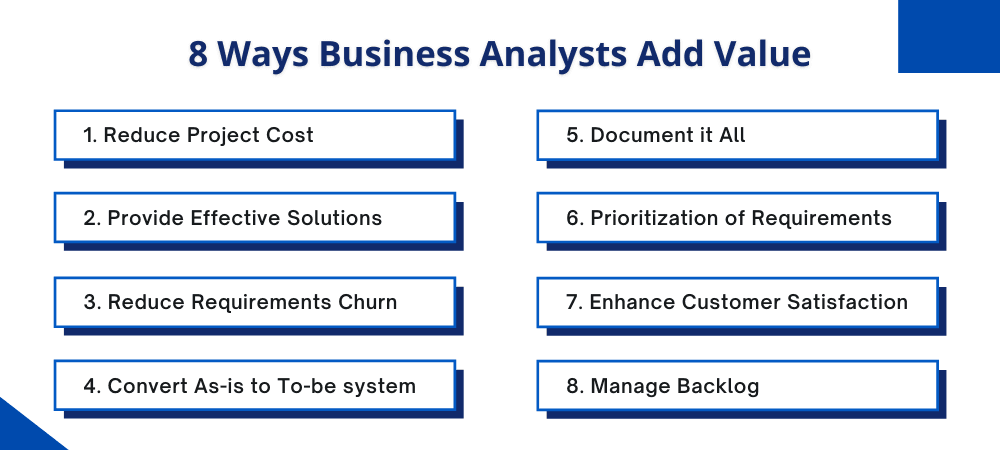How Does a Business Analyst Add Value to Your Business?

Introduction
What do Business Analysts do and how do they add value? This is a very common question asked by most of us, so let’s understand what BAs really do and how they are business analysts who add value to a business or organization.
The primary work of BA is to identify the needs and requirements of the client, define the scope, document the requirements, and ensure the functionality will yield the desired result.
BAs also ensure that the development team fully understands the requirements for that they ask clarifying questions to clients, provide solutions that do not hamper client needs and ensure the project is running within the timelines.
Let’s see some of the ways business analyst add value during and after the project development life cycle.
8 Ways Business Analyst Add Value to Organizations
Let’s see some of the ways business analysts add value during and after the project development life cycle.

1. Reduce Project Cost
BAs tend to reduce the unseen overhead project costs that may get added due to re-work and change requests if the development team starts software development without completely understanding the business need.
When a BA is involved in the project, it’s his/her responsibility to make sure the development team understands the business requirements thoroughly and hence helps in reducing misunderstandings and incorrect developments which will help indirectly to reduce the project cost.
2. Provide Effective Solutions
Good BAs will present business solutions that are feasible from the development perspective, as well as those which meet the business requirements. As a Business Analyst tends to play the role of a client in the entire product development cycle, he/she will provide solutions keeping in mind the client’s thought process, business goals as well as the development team’s feasibility and timeline.
3. Reduce Requirements Churn
Imagine a high-level client meeting being held again and again without any conclusion on the business requirement and there is no record of the discussion. Here is where BAs will come into play.
BAs will document all the discussions, create logical decisions flowcharts, presentations, wireframes & analytics for visualization so the team can properly relate to the discussion and reduce communication gaps. This will in turn reduce the time taken by the business community to figure out what it is that they actually want.

4. Convert As-is System to To-be System
BAs will understand the current business architecture & workflow and define new business needs, analyze how can the current As-is system be converted to a To-be system, and what changes will be required to do that.
5. Document it All
BAs will draft each and every requirement in detail so that nothing is left out. BAs document the requirements from the Pre-sales phase to the Post-sales phase. There are many types of documents that BAs create, some of them are SRS (Software Requirements Specification), FRD (Functional Requirements Document), BRD (Business Requirement Document), User Stories, etc. Additionally, they create process flow diagrams, Use Cases, workflows, and more for better understanding.
6. Prioritization of Requirements
Now when the requirements are gathered and documented, BAs will prioritize them on the basis of stakeholder needs (if they want to present some part of the product to investors), features that add intense value to the product, etc and then pass it on to the development team.
The most popular prioritization technique is MoSCoW (Most Should Could Would). This is an important step because if the requirements are just passed on to the development team, they may sort them on the basis of technical component or area and then implement that way, hence implementation would not be in the desired way.
7. Enhance Customer Satisfaction
Studies have proven that close to 50% of customer-reported issues show up in the requirements phase. BAs ensure they test the developed product on an ongoing basis as well as before the final delivery and most importantly they make sure the issues are resolved even if it is the smallest one.
8. Manage Backlog
An optimal project will have the workflows, user stories, and requirements defined at least two to four weeks in advance of when they’ll have to be developed. In this time span, the development team needs to become familiar with the requirements so that they can create their work plan and find ways to optimize their code or even reuse it.
When a business analyst is involved in a project, he or she will create this backlog in advance, allowing time for clarification of doubts and understanding the requirements in further detail. This way Business Analysts always stay ahead of development and keep proposing distinctive solutions to stakeholders.

Conclusion
Business Analysts help at every step of the project cycle and drive value for the project by acting as a catalyst. Principal ways where business analysts add value are:-
- Increase team’s efficiency
- Define scope and business requirements
- Add a layer of Quality check
- Manage Backlog and Change requests
Having a business analyst in the project is in the best interest of the project as well as the organization.
If you plan to hire dedicated BAs for your projects, please contact us.





